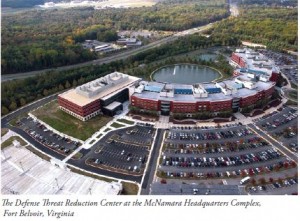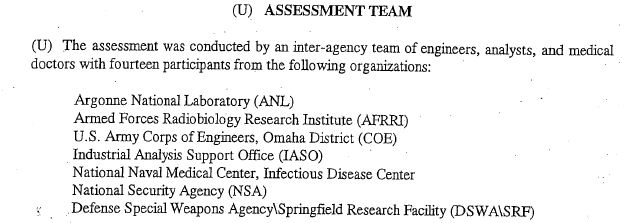Why Didn’t DOJ Look More Closely at DTRA’s Role in 2001 Anthrax Attacks?

The 317,000 square foot DTRA headquarters opened in 2005 to bring together the agency's 2000 employees.
[Note: This post has been updated to correct an error regarding the location of the Project BACUS facility. Erroneous material has not been deleted but has been put into strikethrough font.]
In following up on yesterday’s announcement that the family of Robert Stevens, the first victim in the 2001 anthrax attacks, has settled their wrongful death suit with the US Government for $2.5 million, Marcy came across a number of documents recently released through the case. One of those documents got my attention from its title: “Integrated Capabilities Assessment of the U.S. Army Medical Research Institute of Infectious Diseases” (USAMRIID Capabilities pdf). I had anticipated that the document would be a technical assessment that would be relevant to the question of whether the facilities and equipment available to Bruce Ivins would have been appropriate for production of the anthrax spores used in the 2001 attacks. However, it turns out that the document was a report on a 1996 security assessment of the USAMRIID facility where Ivins worked. I almost moved on to other documents, but then I saw the list of agencies that conducted the review:
 The last entry on the list is what stands out. The Defense Special Weapons Agency was folded into the newly formed Defense Threat Reduction Agency, or DTRA, in late 1998. And DTRA was important to me because they were the agency that carried out Project BACUS, first reported by Judy Miller on September 4, 2001. Miller’s Times article described DTRA building a facility at the
The last entry on the list is what stands out. The Defense Special Weapons Agency was folded into the newly formed Defense Threat Reduction Agency, or DTRA, in late 1998. And DTRA was important to me because they were the agency that carried out Project BACUS, first reported by Judy Miller on September 4, 2001. Miller’s Times article described DTRA building a facility at the Dugway Proving Grounds in Utah Nevada Test Site with a 50 liter fermenter capable of producing bioweapons microbes. The project was an exercise to determine how difficult it would be for authorities to spot a bioweapons production facility built by terrorists. Later, I found that in her bioweapons book published in 2001, Miller disclosed that the BACUS facility also is capable of weaponizing bacterial spores.
With those bits of history in mind, some of the findings from the 1996 assessment stand out. From the introductory material, we find this summary: Read more →
